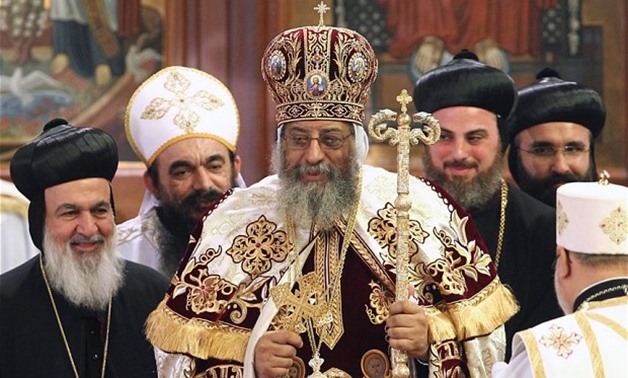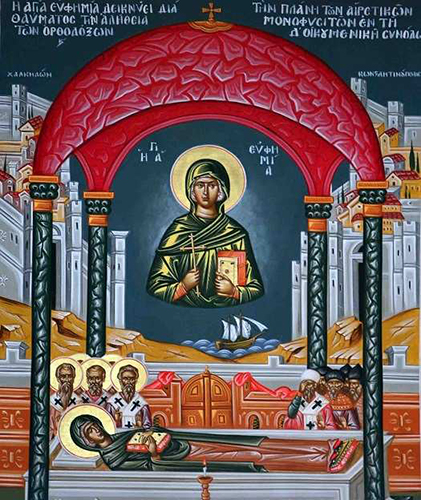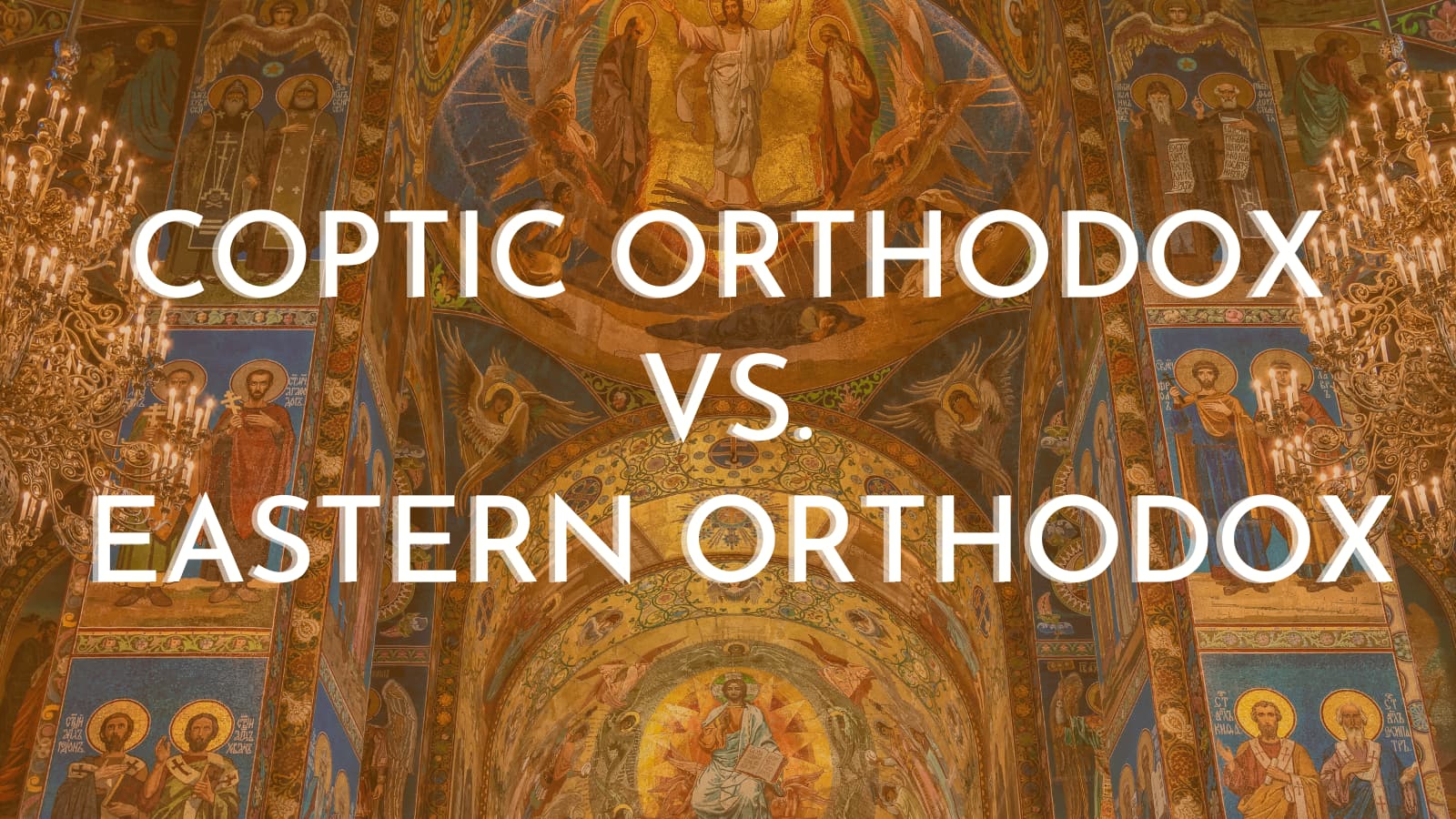Newcomers to Orthodoxy are often surprised to discover that there are different kinds of Orthodox churches. Generally, there are two main confessions that label themselves “Orthodox”: the Oriental Orthodox (Non-Chalcedonian) Communion and the Eastern Orthodox Communion. Perhaps most well known in the former communion is the Coptic Orthodox Church, while the most well known in the latter communion is the Greek Orthodox Church. In this post, we’ll explore the difference between Coptic and Eastern Orthodox and explain why they are not in communion with one another. And we’ll try to keep things as simple as possible!
Estimated reading time: 8 minutes
Table of contents
What is the Oriental Orthodox Communion?
The Oriental Orthodox Communion accepts the first three Ecumenical Councils. Moreover, these churches uphold the declaration of St. Cyril of Alexandria: that there is one incarnate nature of God the Word, a nature that is both fully human and fully Divine.
The Coptic Orthodox (also known simply as Copts) are part of this Communion, along with the Orthodox Churches of Ethiopia, Eritrea, Armenia, and the Syriac Orthodox Church (including the Malankara-Syriac Church of southern India). They are more commonly known as “Miaphysites” – a direct reference to their Christology – or simply as “Non-Chalcedonians”.
Who are the Copts?
The Coptic Orthodox Church is the main Christian Church in Egypt, where it has between 6 and 11 million members. While most Copts live in Egypt, the Church has around a million members outside Egypt; there are over 100 churches in the United States, along with a cathedral in the UK.
The word “Copt” comes from the Greek word ‘Aigyptos‘, meaning Egyptian. Therefore, it sometimes refers to all Egyptian Christians, not just members of the Coptic Orthodox Church.

Copts believe that their Church dates back to around AD 50, when, according to Tradition, the Apostle Mark visited Egypt. This essentially makes the Coptic Orthodox Church ones of the earliest Christian groups to exist outside of the Holy Land. To this day, the Coptic (along with Eastern) Orthodox continue to suffer persecution at the hands of Muslims.
The Coptic Orthodox Church is led by the Pope of Alexandria, based in Cairo. The current Pope, Tawadros II, succeeded Pope Shenouda III and is 118th in succession to St. Mark.
What is the Eastern Orthodox Communion?
The Eastern Orthodox Communion (to which our parish belongs) recognizes all Seven Ecumenical Councils. However, unlike Non-Chalcedonians, Orthodox Churches proclaim that Christ has two natures in hypostatic union. That He is both fully Divine and fully human.
Churches in the Eastern Orthodox Communion include not only the Greek but the Russian, Albanian, Georgian, Antiochian, Bulgarian, and Serbian Orthodox, along with a host of others.
Why are these Churches not in communion with each other?
In AD 451, the Fathers of the Church gathered in Council to reaffirm the doctrine of the Council of Ephesus against the heresies of Nestorianism and Monophysitism. In other words, this Council dealt with the highly controversial topic of Christ’s divine and human nature(s), or Christology. We will dive a bit deeper into this in the next section.
Ultimately, the Oriental Orthodox Churches rejected the Confession of Chalcedon, thus severing themselves from communion with the One Holy, Catholic, and Apostolic Church. In recent years, both sides have reassessed this dispute and its surrounding phraseology; however, communion still has not been re-established for several reasons, including the fact that Non-Chalcedonian churches do not accept any of the Ecumenical Councils past the Third.
The Confession of Chalcedon
The Confession of Chalcedon provides a clear statement on the two natures of Christ, human and divine:
We, then, following the holy Fathers, all with one consent, teach people to confess one and the same Son, our Lord Jesus Christ, the same perfect in Godhead and also perfect in manhood; truly God and truly man, of a reasonable soul and body; consubstantial with the Father according to the Godhead, and consubstantial with us according to the Manhood; in all things like unto us, without sin; begotten before all ages of the Father according to the Godhead, and in these latter days, for us and for our salvation, born of the Virgin Mary, the Mother of God, according to the Manhood;
One and the same Christ, Son, Lord, only begotten, to be acknowledged in two natures, inconfusedly, unchangeably, indivisibly, inseparably; the distinction of natures being by no means taken away by the union, but rather the property of each nature being preserved, and concurring in one Person and one Hypostasis, not parted or divided into two persons, but one and the same Son, and only begotten God, the Word, the Lord Jesus Christ; as the prophets from the beginning [have declared] concerning Him, and the Lord Jesus Christ Himself has taught us, and the Creed of the holy Fathers has handed down to us.
Chalcedonian Definition, emphasis added
This clearly reaffirms the decisions of the Council of Ephesus and the pre-eminence of the Creed of Nicea (AD 325). It also canonizes as authoritative two of Cyril of Alexandria‘s letters and the Tome of Leo written against Eutyches in AD 449.
Why did the Copts reject this?
The Non-Chalcedonian Churches believed the Chalcedonian definition ambiguous and strongly opposed it because of its perceived similarities to Nestorianism. The heresy of Nestorianism greatly stressed the separation between the divine and human aspect in Jesus, which the Non-Chalcedonians perceived as a radical form of Dyophysitism (meaning “two natures”), the official position articulated at the Fourth Ecumenical Council.
Monophysitism vs. Miaphysitism
Miaphysitism greatly stresses the inseparable union of the Divine and human aspects of Jesus into one nature. On its surface, this is not much contradictory to the Eastern Orthodox position of Dyophysitism. However, Miaphysitism can often evolve into Monophysitism, the belief that the Divine and human natures of Christ merged together. And, in fact, many Oriental Orthodox have the tendency to accept such heresy, mostly out of innocent ignorance. This is because of the complexity of the Greek words used to articulate these doctrines: ousia (essence), physis (nature), hypostasis (concrete reality/person), and prosopon (mask/person). Even in Greek, their meanings tend to overlap, which makes this disagreement one of technicality.
Below is a table illustrating the differences between these two beliefs.
| Monophysitism | Miaphysitism |
|---|---|
| Eutychian | Cyrillian |
| One simple nature | One composite nature |
| Christ’s Divinity absorbs His humanity, leaving only one nature preserved after their union | Christ’s Divinity and humanity unite perfectly without creating a different third nature or causing the two composing natures to lose their substance |
| Jesus is not consubstantial with the Father, nor with us | Christ is consubstantial with us and with the Father |
The Miracle of St. Euphemia
The Dogmas of the Orthodox Church are accepted on the basis of “proven common experience” of the Church and divine intervention. The Orthodox Church is inherently unable to err because of the way the Faith is preserved. In the instance of the Fourth Ecumenical Council, the Church’s Confession was proven True by the power of God through one of His Saints.
For the Council, the 630 delegates gathered in the church of Saint Euphemia, where her holy relics were housed. With relatively equal representation on both sides, the meetings were quite contentious. The Fathers could not reach a decisive consensus. Therefore, Patriarch Anatolius proposed that the Council submit the decision of the Church dispute to the Holy Spirit, through St. Euphemia.

Both sides wrote down their confessions of faith on separate scrolls and sealed them. They opened the tomb of the Saint and placed both scrolls upon her bosom. Then, in the presence of the emperor Marcian (450-457), they sealed the tomb, putting on it the imperial seal and setting a guard for three days. During these days both sides imposed upon themselves strict fasting and prayer. After three days the patriarch and the emperor, in the presence of the Council, opened the tomb. In Saint Euphemia’s right hand, they found the scroll with the Orthodox confession, while the scroll of the heretics lay at her feet. And the Saint, as though alive, raised her hand and gave the scroll to the patriarch.
As a result of this miracle, many of the heretics repented and accepted the Orthodox confession. However, those who did not accept it effectively severed themselves from the Body of Christ.
Other “superficial” differences between Coptic and Eastern Orthodox
Aside from the major theological differences we discussed above, there are a handful of smaller things the Copts do differently than the Eastern Orthodox:
- Copts make the sign of the Cross like Roman Catholics, from the left shoulder to the right
- Coptic icons have a different “cartoon” like quality to them compared to Eastern Orthodox icons
- Copts use cymbals in their worship services
- Coptic Orthodox liturgies are usually celebrated in Arabic
- Copts use either the Divine Liturgy of St. Cyril, St. Basil, or St. Gregory
Conclusion
While the Coptic and Eastern Orthodox Churches share many dogmatic positions in common, they differ on a critical matter. However similar their positions may seem, the Holy Spirit guided the Church to articulating the correct Christological dogma: that Christ is fully God and fully Man, both natures distinct, yet united, preserved perfectly in one Hypostasis.
Keep Reading: Who Exactly Is Jesus Christ?


6 Responses
Very informative read . I’ve been considering converting from being Protestant to orthodox. I didn’t know there was that much of a theological difference between Coptic and Eastern Orthodoxy. I went to a Coptic church once in my hometown and almost the entire liturgy was in Arabic. I’ve felt a strong conviction to learn about Orthodoxy since November 2022. God Bless🙏
Landan,
Christ is in our midst! We are glad you found this article informative. May God bless you as you search for the fullness of the Faith!
Well I too believe that I was led by the Holy Spirit here this morning also and I too have a strong unction to convert to Eastern Orthodox as well. I will continue allowing myself to be led by the Spirit of the Lord into all truth for the glory and honor of God the Father. Thank You for Your faithful service to The Lord and the body of Christ in these crucial days. God Bless You!
Thank you, Sharlyn – glory to God!
Very informative! Currently searching to visit for a second time an Orthodox Church to learn more about Orthodoxy. Grew up Protestant,
Hello, thanks for the blog. It’s informative.
A few years ago, I was interested in the difference between churches in general (and in the particular the ecumenical councils and the topic of ‘the nature of Christ’). I read multiple sources and from the sources available (e.g., Greek, Coptic, Roman etc). Though may not be the most accurate, my conclusion was that at least both the Greek and Coptic Orthodox Churches are aligned concerning the nature of Christ (see https://www.copticchurch.net/pdf/theology/nature_of_christ.pdf) which does not contradict what’s in the post.
Their rejection of the Chalcedon council was an almost inevitable outcome after the events of the Second Council of Ephesus in 449, language used and events that occurred in between the two councils (including Eutyches and actions by Rome that were not dissimilar to what contributed to the Great Schism in 1054)
Lastly, in relation to “However, Miaphysitism can often evolve into Monophysitism, the belief that the Divine and human natures of Christ merged together.” This seems to be the same as the Copts’ position but at the other end, i.e., the position the Copts understood the council took, from their perspective, could have evolved in Nestorianism.
In conclusion, was it confusion from both sides, misunderstanding, something political or a genuine difference? Based on the teachings of both churches today and their own documented history, I’m led to believe it’s not what they believe in when it comes to the ‘nature of Christ’.
Let us all pray for one united church, as one God’s people.
May the Lord bless you all.